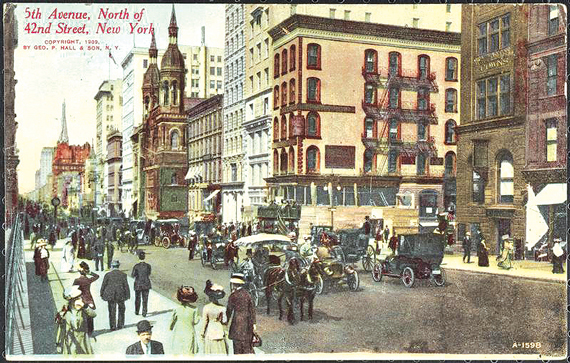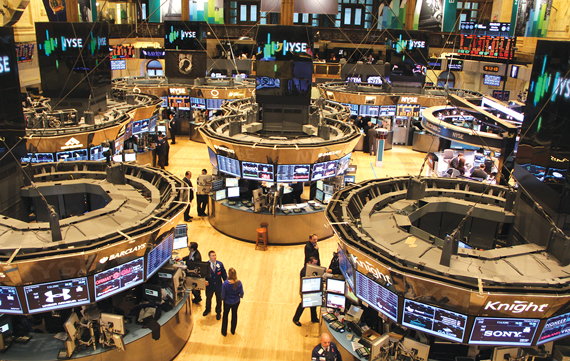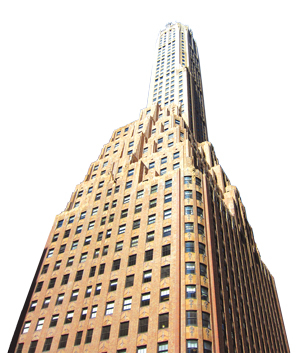Trending
This month in real estate history
Fifth Avenue business district is born, real estate “stock exchange” proposed and Columbia University gets an Art Deco skyscraper

1907: Fifth Avenue Association is formed
Merchants and residents of Fifth Avenue floated plans to organize a business improvement group called the Fifth Avenue Association 109 years ago this month. Thirty merchants, led by Robert Grier Cooke, held their first meeting at the Fifth Avenue Hotel. The association, a predecessor of today’s business improvement districts, sought to improve the condition of Fifth Avenue between 31st and 42nd Streets. Among the first issues at hand was improving garbage collection and street lighting — and alleviating traffic. “The congestion of this part of Fifth Avenue is very great, and this should, by all means, be done away with,” Cooke said at the first meeting. At the time, the genteelness of Fifth Avenue was under threat from a burgeoning garment district. Cooke’s attempts to protect the avenue from sweatshops, loft buildings and skyscrapers, and the crowds of loiterers they brought with them, proved to be only partially successful. By 1908, the hotel that was the site of the association’s first meeting was demolished to make way for a taller building, the International Toy Center. The association was succeeded in 1993 by the Fifth Avenue Business Improvement District. It is one of 72 BIDs in New York City.

Today, REITs are traded on the New York Stock Exchange.
1957: Stock exchange for NYC real estate proposed
An investment banker named Strabo Claggett launched an ill-fated attempt to create a realty stock exchange 59 years ago this month. Claggett, who ran Whitney-Phoenix Company, a financial services firm in New York, sought to provide a central marketplace for real estate transactions. The New York Electronic Real Estate Exchange would enable as many as 2,000 brokers to sell and buy commercial, industrial and residential buildings as well as leaseholds, fractional titles and other forms of real estate ownership in the city. Under the system, “realty will be accorded a measure of liquidity never before realized,” Claggett told the New York Times. Properties listed for sale through the exchange would have their trading date announced in advance so as to give an appraisal committee as well as bidders time to evaluate the properties before their official offering dates. Although Claggett, who died in 1966, spoke of positive reception to his idea, the stock exchange did not succeed. Today, investors can instead buy shares in publicly listed real estate investment trusts, mortgage-backed securities and various other real estate-related derivatives.

570 Lexington Avenue
1993: G.E. gives skyscraper to Columbia University
Columbia University received the gift of an Art Deco skyscraper in Midtown from the industrial conglomerate General Electric 23 years ago this month, an indication of how moribund Manhattan’s office market was at the time. The 50-story, 640-foot-tall building at 570 Lexington — valued at $40 million — was the second-largest donation the university had ever received, exceeded only by a $60 million gift from philanthropist John Kluge. “It may not be the largest gift in the history of Columbia, but we believe it’s the tallest one,” Dennis Dammerman, senior vice president of finance at General Electric, told the New York Times. In return, General Electric, which had moved its headquarters to Fairfield, Connecticut, in 1974, was able to reduce its tax bill by $40 million as well as get rid of a building that was nearly two-thirds vacant. In 1995, Columbia entered a joint partnership with the Mendik Co., a real estate owner and manager, and Quantum Realty Partners to refurbish the building. Bernard Mendik, who gave up half his interest in the building in 1997 after selling his firm to Vornado, wound up buying the building from Columbia and Vornado in 2001 for $120 million. The building is today owned by Tower 570 Company, LP, an affiliate of the Feil Organization. Its tenant roster includes the Real Estate Board of New York. Compiled by Marynia Kruk




